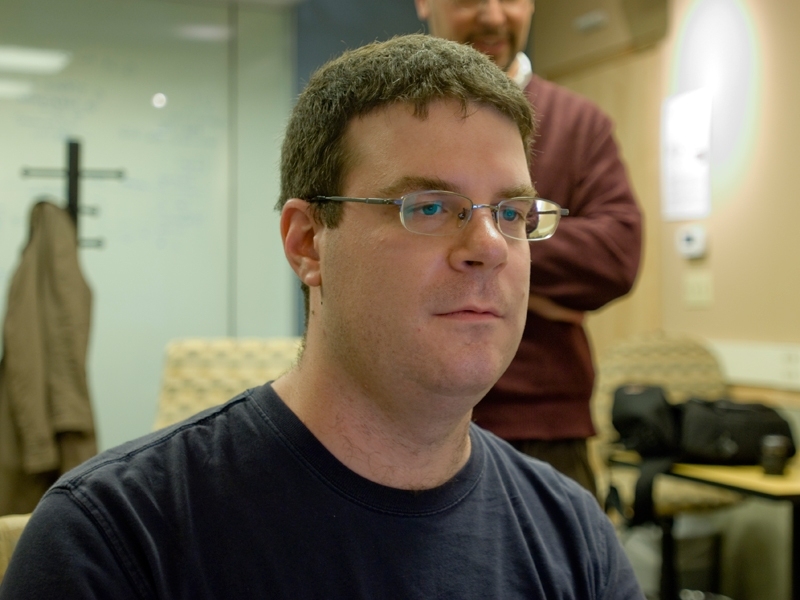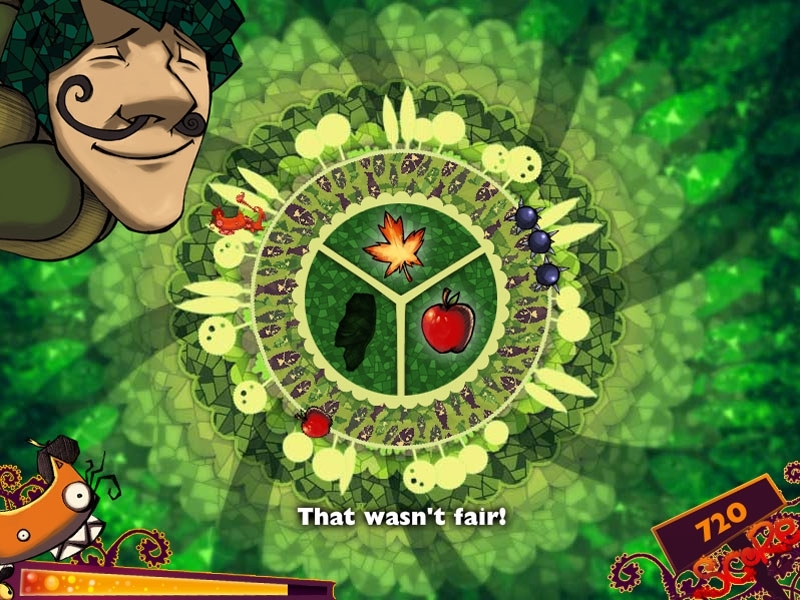In our “Reporter’s Notebook” series, we feature first-person accounts of News Office writers on life at the Institute.
Every Friday afternoon, the Singapore-MIT GAMBIT Game Lab opens its doors to anyone who wishes to drop by and play. On one such recent day, Jason Begy, a graduate student in the Comparative Media Studies program and a GAMBIT researcher, greeted a visitor from the MIT News Office before offering him tea and a place to hang his coat.
Whether the games themselves are as welcoming to visitors is another matter, however. In fact, it is a research issue: How do video-game players respond to the failure they feel when struggling at hard games? Finding the right balance between difficulty and reward is no trivial matter in an industry with nearly $12 billion in 2008 sales, according to its trade group, the Electronic Software Association. It is the kind of problem that GAMBIT, an interdisciplinary research collaboration into gaming between MIT and the government of Singapore, frequently tackles.
To analyze this particular question firsthand, Begy and his guest sat down and started playing “Pierre: Insanity Inspired,” a game Begy helped design. In “Pierre,” each player uses arrow keys to control a small animated cat situated on the edge of a spinning circle. The goal is to get the cat to scoop up desirable objects (such as apples) that float onto the edge of the circle while keeping the cat from being clobbered by ominous-looking spiked balls, resembling floating land mines, that stream in from the edges of the screen.
“Pierre” took shape as one of six game prototypes GAMBIT researchers developed this summer; each game addresses a particular research problem. In this case, “Pierre” tests how positive and negative feedback influences a player’s results by providing dramatic visual and aural messages. When the cat in “Pierre” successfully grabs apples, the game may flash “Nice!” while a voice loudly exclaims the same. When the floating land mines hit the cat, the game briefly stops, and users hear a taunting message, like: “Butterfingers!”
For some reason, the negative messages began sounding as soon as Begy’s visitor started playing. First one land mine hit the cat. “You’ll never be able to do this!” the game exclaimed. Soon another mine struck: “This is just embarrassing!”
In fairness, the visitor was suffering a sore right wrist from copious amounts of typing, and the first game quickly ended with a meager-seeming score of 390. The second game produced a score of 450 and a new message: “You’re the worst player ever!”
Begy surveyed the results. “We would look at that and say, ‘Well, there’s certainly going to be a learning curve,’ ” he noted. Whether that curve charts upward, or downward in the face of frequent negative feedback, is another matter. “Pierre” is considered a difficult game.
“One of the ideas this game is based on is the theory of learned helplessness,” explained Begy. “If people fail enough at a task and don’t get any support, they will eventually think they can’t do it, and then they’ll approach other things like that. You see this all the time: ‘I can’t program my VCR.’ That’s learned helplessness in action. I’m sure 90 percent of people are totally capable of doing these things.” A refined version of “Pierre,” to be finished in 2010, will store data from players’ performances on a server to let researchers analyze whether effects like learned helplessness can be observed.
By systematically studying how games function, GAMBIT is part of an emerging field: academic gaming studies date to the late 1990s, though scholars in the field believe they are simply looking at a new expression of an ancient social activity. “Of all the cultural forms that academics study, games are among the oldest, but they get the least attention,” Begy said.
Begy was explaining some of this while casually rolling up a score of 8,610. The voice of “Pierre” boomed with a distinctly affirmative message: “You’re still the best!”
Begy’s visitor took another turn, and quickly improved to 600. But a fourth stab at “Pierre” resulted in a lower score. “Are you always this useless?” taunted the voice. What seemed to be on display was not so much learned helplessness, but just plain old natural helplessness.
“From a marketing standpoint, you want people to continue even when they lose,” noted Begy. “Some people are more invested and take it personally.” Another floating land mine hit the cat. “But you’re laughing.”
At the Singapore-MIT GAMBIT Game Lab, researchers examine what makes video games click with players — or what doesn't.
Publication Date:

Caption:
A visitor tests his hand at playing 'Pierre' at the Singapore-MIT GAMBIT Game Lab one Friday afternoon.
Credits:
Photo: Patrick Gillooly

Caption:
Jason Begy, a graduate student in the Comparative Media Studies program and a GAMBIT researcher, plays 'Pierre' in the Game Lab offices.
Credits:
Photo: Patrick Gillooly

Caption:
A screenshot from "Pierre: Insanity Inspired," which was developed at the Singapore-MIT GAMBIT Game Lab.
Credits:
Courtesy of the GAMBIT Game Lab

Caption:
A screenshot from "Pierre: Insanity Inspired," which was developed at the Singapore-MIT GAMBIT Game Lab.
Credits:
Courtesy of the GAMBIT Game Lab





